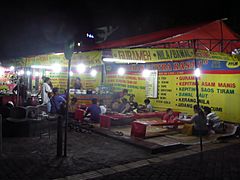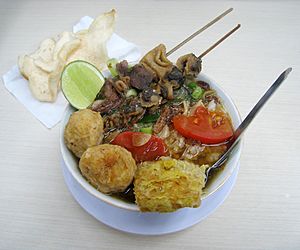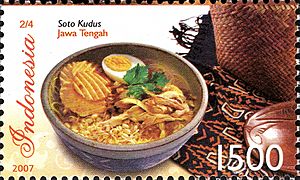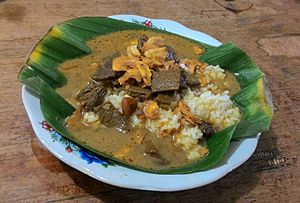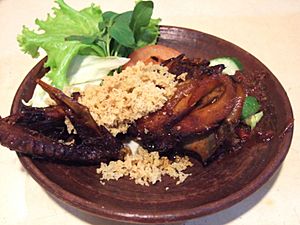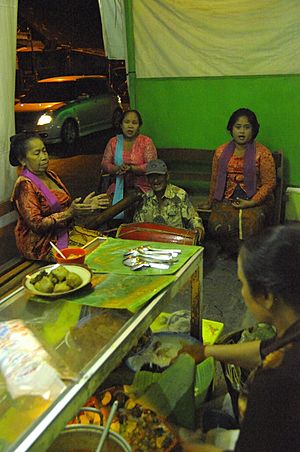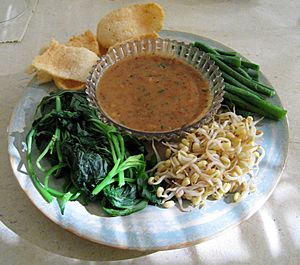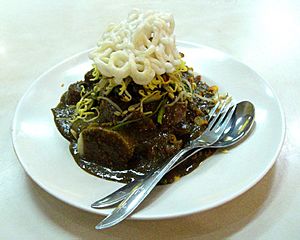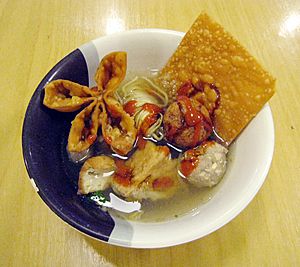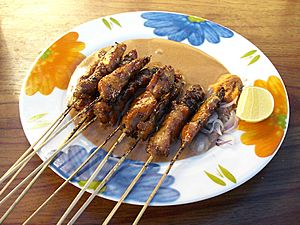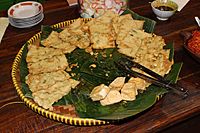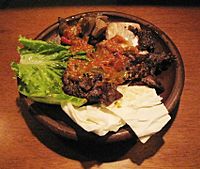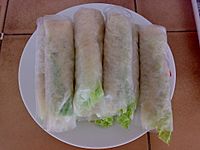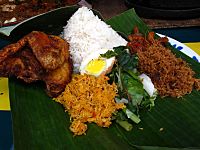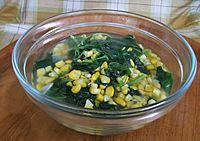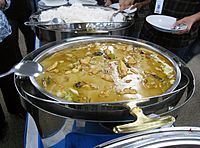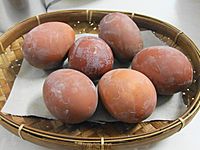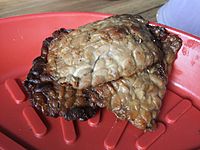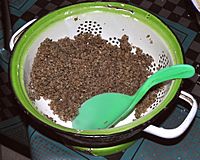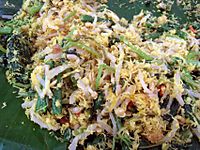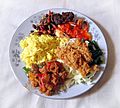Javanese cuisine facts for kids
Javanese cuisine is the yummy food from the Javanese people. They are a big group of people living in Indonesia, especially in places like Central Java, Yogyakarta, and East Java. This food is often enjoyed in other countries too, thanks to Javanese people living there.
There are many different groups of people on the island of Java. Javanese cuisine is just about the food made by the Javanese people themselves.
Some people think Javanese food is always sweet. This is because food from Yogyakarta is often sweet. But Javanese food comes from many areas. For example, in northern Central Java, food can be salty and spicy. In East Java, it gets even spicier! Today, Javanese people move around a lot, so these old ideas about regional tastes are not always true anymore.
Contents
A Taste of History: Ancient Javanese Food
Long ago, people in Java wrote down their recipes! Historians have figured out some of these ancient dishes from old writings. From the 8th to 10th centuries, during the Medang Mataram era, people enjoyed foods like:
- Hadangan Harang: This was like a satay (meat on a stick) made from minced water buffalo.
- Hadangan Madura: Water buffalo meat cooked with sweet palm sugar.
- Dundu Puyengan: Eel seasoned with a herb called lemon basil.
They also had cool drinks like:
- Nalaka Rasa: Sugarcane juice.
- Jati Wangi: A drink made with jasmine flowers.
- Kinca: Refreshing tamarind juice.
People also ate Kuluban (boiled vegetables with spices, like today's urap) and Phalamula (boiled yams and tubers with liquid palm sugar).
Food in Javanese Celebrations
In Javanese culture, food is a super important part of special events. For example, the selamatan ceremony is a way to show thanks. It usually involves a big meal where everyone eats together. People often prepare and cook the food as a team. This shows how Javanese people like to work together (gotong-royong) and have a friendly community spirit (guyub). It also celebrates having plenty of food and being thankful.
Many Javanese foods have become popular all over Indonesia. Some have even inspired dishes in other regions. Think of lontong (rice cakes), tumpeng (cone-shaped rice), and krupuk (crackers).
Some Javanese dishes also show influences from other cultures. For example, bakmi (noodles) and fried rice come from Chinese cuisine. Satay has Arab roots, and kari (curry) comes from India.
Main Ingredients in Javanese Cooking

Rice is a super important food in Java, and it has been for a very long time. Javanese people even respect Dewi Sri, who is known as the Rice Goddess. Steamed rice is the main food eaten at every meal.
- Tumpeng: This is a special cone-shaped yellow rice. It's a must-have for slametan, which are traditional Javanese ceremonies.
- Rice can also be made into lontong or ketupat (rice cakes).
- Or it can be cooked in coconut milk to make nasi liwet.
- It can also be colored yellow with turmeric to make nasi kuning (yellow rice).
Sometimes, other foods like gaplek (dried cassava) are mixed with rice or used instead of rice. Poor people sometimes ate gaplek when rice was hard to find.
- Tubers like yam, taro, and sweet potato are eaten as snacks.
- Bread and other grains are not very common.
- But noodles and potatoes are often served with rice. Potatoes are sometimes mashed, spiced, shaped into discs, coated in egg, and fried to make perkedel.
Noodles like wheat noodles, bihun (rice vermicelli), and kwetiau came from Chinese cooking. Javanese people made them their own by adding kecap manis (sweet soy sauce) and local spices. This created dishes like bakmi Jawa and bihun goreng.
Vegetables are a big part of Javanese food. You'll find lots of veggies in dishes like pecel, lotek, and urap.
Common Spices and Meats
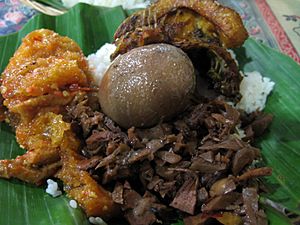
Many Javanese dishes use these common ingredients and spices:
- Coconut milk
- Peanut sauce
- Gula jawa (palm sugar)
- Asem jawa (tamarind)
- Petis and terasi (shrimp paste)
- Shallots, garlic, turmeric, galangal, ginger
- Chili sambal (a spicy sauce)
Freshwater fish like carp, tilapia, gourami, and catfish are popular. In Javanese cities near the coast, people enjoy seafood like tuna, red snapper, wahoo, ray, anchovy, shrimp, squid, and various salted fish.
Popular meats in Javanese cooking include chicken, goat meat, beef, and lamb. Besides regular farmed chicken, ayam kampung (free-range chicken) is popular because it has a leaner, more natural taste.
Most Javanese people are Muslim. This means that most Javanese food does not include pork. However, in some small areas where Javanese people are Catholic, pork might be eaten.
Where to Find Javanese Food
Javanese families usually buy fresh ingredients from the local market each morning. They cook the food and serve it for lunch. Any leftovers are saved and heated up for dinner.
Besides homemade meals, you can find Javanese food everywhere! From simple street carts and warungs (small food stalls) to fancy restaurants in big hotels.
- Small family-run warungs are great for cheap street food. They sell everything from full meals to snacks.
- Popular simple Javanese food places include Warung Tegal, run by people from Tegal, and Angkringan street carts in Yogyakarta and Solo. These carts sell cheap sego kucing (small rice portions) and different wedang (hot drinks).
Lesehan Style Dining
In Javanese tradition, it's common to eat lesehan style. This means sitting cross-legged on a mat while eating at a low table. This style became popular with tourists on Malioboro street in Yogyakarta. Today, you can find lesehan food stalls in many cities, like Surakarta, Semarang, and Jakarta.
- Javanese cuisine outlets
-
Street-side Javanese chicken satay vendor near Borobudur.
Central Javanese Dishes
Food in Central Java is influenced by the old kingdoms of Yogyakarta and Surakarta (also called Solo). Most Central Javanese dishes were created there.
However, in coastal cities like Semarang and Pekalongan, you can see influences from Chinese cuisine. Examples include lumpia (spring rolls) and bakmi Jawa. In the royal court of Surakarta, you might find European influences, like bistik Jawa (Javanese steak) and selat Solo (Solo salad).
Many dishes from Central Java are named after the place where they first became popular.
Semarang Specialties
- Bandeng Juwana: This is a special milkfish with tender bones from Juwana, near Semarang.
- Lumpia Semarang: Fried or steamed spring rolls. They are usually filled with meat and bamboo shoots. They come with a sweet fermented soybean sauce or sweet garlic sauce.
- Nasi ayam: A dish with rice, chicken, egg, tofu, and a sweet-salty coconut milk gravy.
- Soto Semarang: A chicken soup served in a small bowl. It has rice, perkedel (potato patties), and satay made from cockles or chicken intestines.
- Wingko Babat: A cake made from glutinous rice and coconut. It's toasted and sold warm. Even though it's from Babat in East Java, it's very popular in Semarang.
Jepara Delights
- Soto Jepara: A chicken soup from Jepara.
- Opor panggang: A special chicken dish from Jepara. The chicken is roasted in a clay pot first, giving it a unique taste.
- Kuluban: A traditional salad from Jepara Regency.
- Horok-horok: Steamed corn starch that looks like small granules. It's chewy and can be eaten with meatballs or satay.
- Bongko mento: A snack wrapped in a banana leaf. It has omelet filled with shredded chicken, mushrooms, and glass noodles.
- Singit: Beef shank cooked slowly in coconut milk and soy sauce until the sauce is thick.
- Sate sapi Jepara: Satay made from cow meat with special Jepara spices.
Kudus Cuisine
- Jenang Kudus: A sweet treat made from rice flour, palm sugar, and coconut milk.
- Soto Kudus: A chicken soup from Kudus.
Pati Flavors
- Bandeng presto: Pressure cooked milkfish. The bones become soft, and the spices soak into the fish perfectly.
- Nasi gandul: Beef served on white rice with a spicy, savory soup. It's often served on a banana leaf.
- Sayur mangut: A hot and spicy Ariid catfish head cooked in coconut milk.
Yogyakarta's Sweet and Savory

- Ayam geprek: Crispy battered fried chicken that is smashed and mixed with hot sambal.
- Ayam goreng Kalasan: Chicken cooked in spices and coconut water, then deep-fried until crispy.
- Bakpia and bakpia pathok: A sweet pastry with sugared mung bean paste inside. It comes from Chinese pastries.
- Brongkos: Spicy meat and black-eyed peas stew in coconut milk.
- Gudeg: A famous traditional food from Yogyakarta. It's made from young unripe nangka (jackfruit) boiled for hours with palm sugar and coconut milk. It's usually served with fried chicken and spicy beef skin crackers. Yogyakarta's gudeg is sweet and savory, and more reddish because of Javanese teak leaves.
- Kipo: A small sweet snack from Kotagede. It's made of glutinous rice flour and coconut milk dough, filled with grated coconut and palm sugar.
- Krechek (or sambal goreng krechek): A spicy beef skin dish made from seasoned beef skin crackers. It's often served with gudeg.
- Nasi kucing: Rice with small side dishes, often sold cheaply.
- Wedhang ronde (ronde): A hot Javanese dessert. It has glutinous rice balls filled with peanut paste, floating in a sweet ginger and lemongrass tea.
- Wedhang uwuh (uwuh): A hot Javanese clove drink.
Solo's Special Dishes
- Bakso Solo: Meatballs made of beef in hot soup. This version from Solo has super-sized meatballs, sometimes as big as tennis balls!
- Bistik Jawa: Javanese beef steak, influenced by European cooking.
- Nasi liwet: A rice dish cooked in coconut milk and chicken broth, served with meat and vegetable side dishes.
- Sate buntel: Minced fatty beef or goat meat wrapped around a bamboo skewer and grilled. It's quite large, like a Middle Eastern kebab.
- Selat Solo: A salad with stewed beef, lettuce, carrot, green beans, and potato chips in a sweet spiced dressing.
- Srabi Solo: A pancake made of coconut milk and a little rice flour. It can be plain or have toppings like sliced banana or chocolate sprinkles.
- Tongseng: A strongly spiced curry of bone-in mutton, quickly stir-fried with vegetables.
- Tengkleng: Goat ribs and offal in a curry-like soup. It's similar to gule kambing but lighter.
- Timlo Solo: A beef and vegetable soup.
Banyumas Flavors
This area is in Western Central Java, near West Java.
- Nasi bogana Tegal: Steamed rice wrapped in banana leaves with different side dishes.
- Sate Tegal or Sate Balibul: Satay made from young (five-month-old) goat meat from Tegal, known for being very tender.
- Sate Ambal: A satay from Ambal, Kebumen. It uses free-range chicken and a special sauce made from ground tempeh, chili, and spices, not peanuts.
- Sroto Sokaraja: A type of soto from Sokaraja, Banyumas.
- Teh poci Tegal: Tea brewed in a clay teapot, served with rock sugar. Tegal is famous for its good tea.
- Tempeh mendoan: Fried battered tempeh from Banyumas.
East Javanese Dishes
East Javanese food is greatly influenced by Madurese cuisine. Madura is known for making a lot of salt, so many dishes there don't use sugar. Many East Javanese dishes are also typically Madurese, like soto Madura and sate Madura.
You can also find influences from Arabic and Indian food in coastal cities like Tuban, Gresik, Surabaya, Lamongan, and Sidoarjo. This is because many people of Arab descent live in these cities.
Madiun Specialties
- Brem Madiun: Fermented sugar and cassava cakes.
- Pecel Madiun: A salad of boiled vegetables with a spicy peanut sauce. It's usually eaten with rice.
Lamongan Favorites
- Ayam penyet: Fried chicken that's lightly smashed with a pestle and mixed with sambal.
- Bebek goreng: Deep-fried duck.
- Pecel lele: Deep-fried catfish with sambal, vegetables, and rice.
- Soto Lamongan: Chicken soup from Lamongan.
- Tahu campur: Fried tofu served in a beef stew made with petis (shrimp paste).
Surabaya's Unique Flavors
- Ayam penyet: "Smashed chicken," fried chicken that's pressed to make it softer, served with sambal and other sides.
- Lontong kupang: Lontong (rice cakes) with small cockles in petis sauce.
- Rawon Surabaya: A dark beef soup. The dark color comes from kluwak nuts. It's served with mung bean sprouts and sambal.
- Rujak cingur: A unique salad with marinated cow snout or lips (cingur). It's served with boiled vegetables and shrimp crackers, all covered in a sauce made from caramelized fermented shrimp paste, peanuts, and chili. It's a traditional food of Surabaya.
- Semanggi: A salad made from boiled semanggi leaves (which grow in rice fields). It has a spicy peanut sauce.
Madura's Famous Dishes
- Sate Madura: A very famous satay from Madura. It's often made from mutton or chicken. The special part is the black sauce made from Indonesian sweet soy sauce mixed with palm sugar, garlic, peanuts, and shrimp paste. Chicken Madura satay usually has peanut sauce, while mutton satay has sweet soy sauce.
- Soto Madura: A beef and offal soup with turmeric, served with boiled egg slices and sambal.
Malang's Delicious Eats
- Bakso Malang: Bakso means meatball. Bakso Malang has more than just meatballs (usually beef). It also includes offal, dumplings (fried or steamed), tofu filled with meat, and noodles, all in a hot beef broth.
- Cwie mi: A Chinese-influenced noodle dish with boiled noodles, minced meat (often chicken), and boiled wonton.
Banyuwangi's Specialities
- Bolu klemben: A tortoise-shaped cake made from flour, eggs, and sugar.
- Botok tawon: A type of botok made from bee larvae.
- Pelasan: The Osing (local ethnic group) style of pepes food, where ingredients are cooked inside a banana-leaf package.
- Pindang koyong: Fish cooked in a yellow, gravy-like soup with various spices.
- Rujak soto: A unique mix of vegetable salad with soto (beef or tripe soup).
- Sale pisang: Chips made from thin slices of bananas that are dried in the sun. They can be eaten as is or fried.
Other East Javanese Foods
- Lontong balap: Means "racing rice cake." It's a dish of rice cakes, fried tofu, and bean sprouts, covered in sweet soy sauce and sambal. In the past, sellers carried heavy metal pots, making them walk very fast, like they were "racing."
- Madumongso: A sweet treat made from fermented black glutinous rice, cooked in coconut milk and sugar. It's sticky and sweet, wrapped in corn husk.
- Sate Ponorogo: A type of satay from Ponorogo. It's made from sliced marinated chicken, served with a peanut and chili sauce. Each skewer has one large piece of chicken.
- Tahu campur: A beef and offal soup mixed with fresh vegetables, potatoes, rice cake, and tofu. The secret ingredient is the caramelized fermented shrimp paste (petis) mixed in just before serving.
- Tahu tek-tek: A dish with cut-up fried tofu, boiled vegetables, and potatoes, covered in a peanut-based sauce with shrimp paste, chili, and garlic.
Common Javanese Dishes You'll Find Everywhere
These Javanese dishes are popular and can be found all over Java:
- Apem: A traditional steamed cake made from rice flour, coconut milk, and palm sugar. It's usually served with grated coconut.
- Ayam goreng: A fried chicken dish with various spices.
- Ayam kecap: Chicken cooked in sweet soy sauce.
- Bakmi jawa: Wheat noodles topped with minced chicken seasoned in soy sauce and green vegetables.
- Bakso: Meatballs (beef or chicken) served in a hot soup with noodles, vegetables, and tofu.
- Bakwan: Fried patties made of vegetables and batter, often sold as a snack.
- Bergedel: Fried patties made from ground potatoes, meat, or tofu.
- Botok: Shredded coconut mixed with other ingredients like vegetables or fish, wrapped in a banana leaf and steamed.
- Bubur ayam: Rice congee (porridge) with shredded chicken and other toppings.
- Bubur kacang hijau: A sweet dessert made from mung beans porridge with coconut milk and palm sugar.
- Bubur ketan hitam: A sweet dessert made from black glutinous rice porridge with coconut milk and palm sugar.
- Bubur sumsum: White congee made from rice flour, eaten with brown sugar sauce.
- Buntil: Shredded coconut mixed with anchovies and spices, wrapped in a papaya leaf, then boiled in coconut milk.
- Dawet: An iced sweet dessert with green rice flour jelly, coconut milk, and palm sugar syrup.
- Donat jawa: Javanese-style ring-shaped fritter made from cassava.
- Garang asem: A chicken dish cooked in banana leaves, known for its sour and spicy taste.
- Gorengan: A mix of fried snacks like tempeh, tofu, and vegetables.
- Gule: A soupy, curry-like dish made from various ingredients like meat or vegetables. Popular ones are gule kambing (goat) and gule ayam (chicken).
- Iga penyet (squeezed ribs): Fried beef ribs served with spicy sambal terasi.
- Kare: The Javanese version of curry dishes, made with meat or vegetables.
- Klepon: Green glutinous rice balls filled with palm sugar, rolled in grated coconut.
- Keripik tempe: Tempeh chips, thinly sliced and deep-fried.
- Kupat: Rice dumplings made from rice packed inside a woven palm leaf pouch.
- Lontong: Pressed rice cake wrapped in banana leaves.
- Lumpia: Spring rolls with savory or sweet fillings.
- Lotek: Similar to gado-gado but sweeter, with different vegetables and often served with crackers.
- Martabak: Stuffed pancake, sometimes filled with beef and scallions.
- Mie ayam: Chicken bakmi dish with seasoned yellow wheat noodles and diced chicken.
- Mie goreng: Spicy fried noodle dish seasoned with sweet soy sauce. Mie goreng jawa is a popular type.
- Nasi ambeng: Fragrant Javanese rice dish with steamed white rice, chicken curry, fried sambal, and other sides.
- Nasi goreng (fried rice): Javanese-style Indonesian fried rice.
- Nasi kuning: Rice cooked in coconut milk, colored bright yellow with turmeric, and scented with lemongrass.
- Nasi rames: Rice with different side dishes, like vegetable stew, fish, chicken, and spicy sambal.
- Pecel: A type of peanut sauce with chili, used in various dishes or with rice and vegetables as nasi pecel.
- Putu: Traditional green steamed cake made of rice flour, filled with palm sugar, and steamed in bamboo tubes.
- Rempeyek: Deep-fried savory Javanese cracker made from flour with other ingredients like peanuts.
- Rengginang: Thick rice cracker made from cooked glutinous sticky rice, seasoned, sun-dried, and then deep-fried until crispy.
- Roti bakar (grilled bread): Javanese-style toast sandwich with fillings like chocolate sprinkles or jam.
- Rujak: Traditional fruit and vegetable salad.
- Sambal: Chili sauce or paste made from various chili peppers and other ingredients like shrimp paste and garlic. There are many types of sambal.
- Satay: Skewered grilled meat, a common dish in Java with many regional types.
- Sayur lodeh: Mixed vegetables stewed in coconut milk.
- Semur jawa: Meat or vegetable stew braised in a thick brown gravy, mainly using sweet soy sauce and spices.
- Serabi: Rice pancake made from rice flour and coconut milk.
- Soto: A popular Indonesian soup dish in Java, with many regional variations.
- Tahu: Fermented soy food, like a soy milk cheese. It can be fried, stewed, or used in soups.
- Tahu goreng: Deep-fried tofu served with condiments like shrimp paste or soy sauce.
- Tapai: Traditional fermented rice or starchy food.
- Telur pindang: Marbled eggs boiled with herbs and spices.
- Tempeh: A meat substitute made from soybeans fermented with mold. It's a key source of protein in Java.
- Tiwul: Boiled rice substitute made from dried cassava.
- Tumpeng: Rice served in the shape of a conical volcano, often yellow from turmeric. It's an important part of Javanese ceremonies.
- Urap sayur: Vegetables with a spiced grated coconut dressing.
- Jajan pasar: Various types of cakes and snacks made from flour and rice flour, often sprinkled with coconut and drizzled with melted palm sugar. These are usually found in traditional markets.
Images for kids
-
Nasi kuning with urap, fried beef, anchovy and peanuts, potato and shrimp in sambal.
See also
 In Spanish: Gastronomía de Java para niños
In Spanish: Gastronomía de Java para niños




